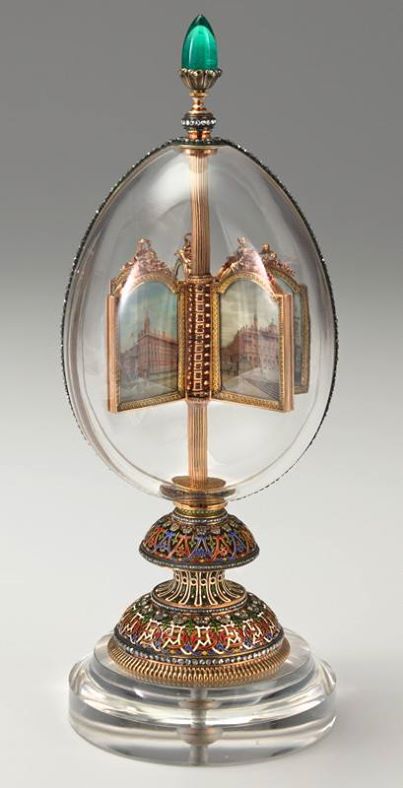Revolving Miniatures Egg
The Revolving Miniatures original Faberge egg is one of the 52 jeweled Easter eggs. Made for the Imperial Royal Family by Peter Carl Faberge.
The Revolving Miniatures, also known as the Rock Crystal egg. The egg was created for Empress Alexandra Feodorovna, by the commission of Tsar Nicholas II.
The egg was the first of the Imperial eggs that was received by Nicholas II and not Alexander III. As such, it is the egg that is most associated with the coronation of the new Tsar. Although the actual meaning of the egg is far more romantic and personal.
Origins of the Rock Crystal Egg
Nicholas gifted Alexandra the egg on March 24th, 1896. While the egg is one of the real Faberge eggs that was created as a gift as opposed to a commemoration. It was the egg crafted for the year that the couple ascended the Russian throne. As such, Nicholas ensured that the egg held special meaning for his wife, as was apparent in the miniatures inside.
External description of the Revolving Miniatures Faberge egg
The egg is about nine and three-quarters of an inch tall, and three and seven-eights of an inch wide.
The shell of the egg is created from rock crystal, hence the alternative name to the egg. This shell is banded with emerald enameled gold that is studded with diamonds. At the top of the egg, a 27-carat Siberian emerald sits in an emerald enameled gold mount. The emerald is cabochon style and is the largest that Faberge used for any of the Imperial eggs.
There is a plinth of rock crystal that the egg base sits on. Which was crafted with a multicolor enameled gold double spheroid that has two circles of rose-cut diamonds wrapping around it.
It also has the monograms of Alexandra as Princess Alix of Hesse-Darmstadt. As she was before her marriage, and then as Alexandra Feodorovna, Empress of Russia. Each monogram has the crown of the respective royal house carved from a diamond. The monograms combine to form an unbroken pattern that runs around the base of the egg.
An internal description of Revolving Miniatures Faberge egg
The inside of the Miniatures original Faberge egg is a gold mount that supports 12 miniature paintings, hence the name. The paintings depict various locations in the world that are of significance to Nicholas and Alexandra. In particular, the paintings are romantic in nature, containing places important to the couple’s courtship earlier in their relationship.
The large emerald on the exterior of the egg. Serves as a mechanism to spin the paintings on a carousel system. When pushed down, a system activates to rotate the paintings. Later on, a hook moves down and folds the pictures back, like the pages of a book.
Each frame itself is made from gold and has an emerald on its top. There is a central gold shaft passing through the egg that the frames are attached to.
Who Created the Rock Crystal Egg
The egg was commissioned from Peter Carl Faberge and was completed by his workmaster, Michael Perkin. It was gifted by Nicholas II to Alexandra Feodorovna in 1896. So we can assume the egg was made in the same year.
Where Can You Find the Egg Today?
The Miniatures egg is still in fine condition today and is currently stored in the Virginia Museum of Fine Arts.
The exact valuation of the egg is unknown but is estimated to range upwards of $30 million dollars.
In 1909, the egg was stored in the Empresses’ study in the Winter Palace. It stayed there until 1917, at which point the Bolshevik Revolution took place, resulting in Nicholas II abdicating the throne.
Revolving Miniatures Faberge egg journey following the revolution
The egg was seized, along with an estimated 40 other eggs by the Kerensky Provisional Government. In a later stage, the egg moved to the Armory Palace of the Kremlin in Moscow.
It stayed here until 1930 when it was sold as one of ten eggs to the Hammer Galleries in New York City.
Following this event, in 1945, the egg was the last of five bought by Lillian Thomas Pratt. Who was the wife of General Motors Executive John Lee Pratt.
Following Lillian’s death in 1947, the egg was left to the Virginia Museum of Fine Arts in her will. The egg remains here to this day on display, meaning you can visit it if you wish to.
My name is Sasha, I’m a father of two. Work in the tech industry. For fun I am running a small business in addition to that, sometimes I write and edit content regarding topics that interest me like: entertainment, tech, finance and art.

